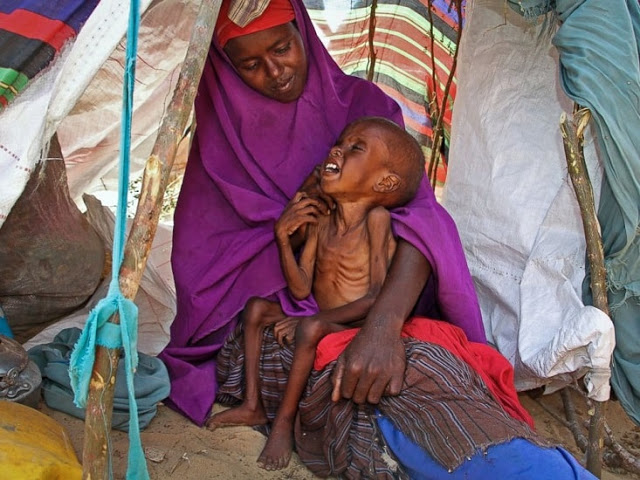by Staff writer
Somalia is one of the four regions (Yemen, South Sudan and northeast Nigeria) the United Nations said are at risk of extreme starvation and diseases in 2017.
The United Nations Children’s Fund (UNICEF) estimated in 2017 that 1.4 million children of Somalia would be acutely malnourished.
“The combination of drought, disease, and displacement are deadly for children,” Steven Lauwerier, UNICEF’s representative in Somalia, said in a public statement.
The drought, impending famine and the presence of Al-Shabaab, a terrorist group, have left the country and its people in a desperate situation.
“The situation is critical in Somalia. People are dying of hunger and there is no water,” victim of the crisis, Noor Ibrahim, told CNN.
“This drought is even worse than 2011. We haven’t seen any food aid yet.”
“Al-Shabaab blocks the roads, there is no access for food aid, the Shabaab steal food as well.”
In 2011, more than a quarter of a million people died during a famine. The United Nations says that more than half died before the famine was even declared.
Now in 2018, the United Nations has stated that about 6.2 million people in Somalia – half the population – need emergency aid, such as food, water and shelter to survive.
The UN is appealing for $1.6 billion in humanitarian aid.
The drought – spanning four consecutive poor rainy seasons – has forced millions from their homes and left hundreds of thousands of children malnourished.
One in four people in the Horn of Africa nation faces the risk of starvation.
Somalia’s 2011 famine killed 260,000 people, half of whom died before the official declaration of famine, caused by drought, war and lack of access for humanitarian aid.
The country has been mired in conflict since 1991. Its weak, Western-backed government is struggling to assert control over poor, rural areas under the Islamist militant group Al Shabaab – challenging the delivery of aid to the most needy.
Somali Prime Minister Hassan Ali Khayre thanked the international community for the $1.3 billion raised last year, but warned there was no room for complacency.
“We face similar challenges and risks this year and the years to follow,” said Hassan.
“Drought and conflict will continue to affect the lives of millions of Somalis. They will continue to displace thousands more. I request on behalf of the government and Somali people for continued support from international partners.”
Since the drought, hundreds of thousands of Somalians – mostly women and children – have been forced to flee their homes due to a persistent lack of rain.
These displaced families are typically sheep or cattle farmers from the north whose animals have all perished or farmers from the south whose lands are parched from the lack of rain.
Many of the water sources they can access are contaminated, leaving people vulnerable to waterborne diseases.
“They see their whole means of livelihood wiped out,” Susannah Price, chief of communication for UNICEF Somalia, told ABC News in 2017.
“There’s nothing for the kids.”
Susannah said infectious diseases “spread like wildfire” in overcrowded displacement camps, and severely malnourished children under the age of five are the most vulnerable.
“They’re the ones who are so weak that if they’re hit by diarrhea or measles or an illness like that, they’re really at risk of dying.”
Ms Price called it an “extremely serious” situation.
If the situation in Somalia escalates into a full-blown famine, it would be the nation’s third famine in a quarter of a century, and the second in less than a decade, the World Health Organization said.
***
Credit:
Reuters
Norwegian Refugee Council
CNN
ABC News
Farah Abdi Warsameh/AP Photo



